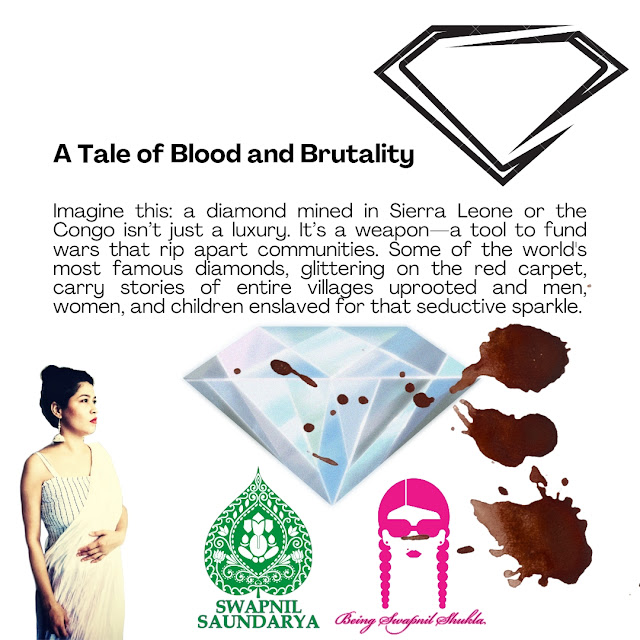Blood Diamonds: Shiny Stones or Dark Secrets? By Swapnil Shukla
Are those glittering diamonds worth the hidden bloodshed? Can we truly ignore the dark path they travel to reach our fingers? These aren't just stones—they’re relics of horror, greed, and violence that have fueled war zones, destroyed lives, and tainted the lives of millions across Africa. Blood diamonds, also called "conflict diamonds," come with a heavy price beyond their carats.
What Exactly Are Blood Diamonds?
Blood diamonds are mined in war-torn regions, often by forced labor, with profits funding brutal militias and dictatorships. From the depths of diamond-rich African mines to the hands of black-market dealers, these stones finance weapons, fuel violence, and displace communities.
A Tale of Blood and Brutality
Imagine this: a diamond mined in Sierra Leone or the Congo isn’t just a luxury. It’s a weapon—a tool to fund wars that rip apart communities. Some of the world's most famous diamonds, glittering on the red carpet, carry stories of entire villages uprooted and men, women, and children enslaved for that seductive sparkle.
The Human Cost: Diamonds Drenched in Blood
The diamond industry still has blood on its hands. Workers endure brutal conditions in diamond mines, often facing violence if they attempt to leave or protest. Children as young as 10 are forced into labor, earning pennies for gems sold for millions. For many, every sparkle of a diamond ring is a reminder of unimaginable suffering.
But Isn’t There a Solution? The Illusion of the ‘Clean Diamond’
The Kimberley Process Certification Scheme (KPCS), established in 2003, was supposed to stop blood diamonds from entering the market. However, loopholes remain, allowing conflict diamonds to slip through the cracks under the disguise of legitimate gems. A “clean diamond” is often just an illusion, hiding the brutal truth behind a veil of legalese.
The Role of Big Jewelry
The big names in jewelry can’t escape responsibility. Many brands claim they don’t deal in conflict diamonds, but a closer look often reveals shaky sourcing practices. Ethical consumers are becoming more aware, demanding proof of conflict-free diamonds, and pressuring brands to change. But is it enough? Or are we simply dressing up a global tragedy in a glossy, high-end box?
What’s the Real Price of Glamour?
In a world increasingly concerned with ethical sourcing, the diamond industry still clings to the appeal of luxury over integrity. When we buy diamonds, we choose not just a product but a legacy. The question is: do we care enough to ensure it’s a legacy of beauty, not blood?
Demanding Transparency: The Rise of the Ethical Diamond Movement
Today, consumers hold power to demand change. Lab-grown diamonds, which are environmentally friendly and free of conflict, are becoming increasingly popular. By choosing lab-grown stones or diamonds with verified ethical sources, consumers can stand against blood diamonds—and challenge the industry to clean up its act.
The Bottom Line: What Can You Do?
If you’re in the market for a diamond, ask questions. Research brands, look for certifications beyond the Kimberley Process, and consider lab-grown diamonds as ethical alternatives. In a world where diamonds represent commitment, the real commitment might be to a stone that sparkles without leaving blood on your hands.
Let’s not glamorize something drenched in violence. After all, who wants a sparkling reminder of someone else’s suffering?
Swapnil Shukla, a pioneering jewelry designer and IGI-Certified Polished Diamond Grader, has redefined the jewelry and fashion industry by inventing the genre of Jewelry Journalism in Hindi. As India's first Jewelry Journalist, her innovative work bridges the gap between high-end jewelry trends and sustainability, making them accessible to Hindi-speaking audiences. A passionate advocate for eco-friendly practices, Swapnil has brought cultural heritage, history, and symbolism into her narratives, contributing to the preservation of indigenous jewelry traditions. Her trailblazing efforts are transforming jewelry journalism into a literary art, setting new benchmarks for responsible design and storytelling.
No part of this publication may be reproduced , stored in a retrieval system or transmitted , in any form or by any means, electronic, mechanical, photocopying, recording or otherwise, without the prior permission of the copyright owner.
Copyright infringement is never intended, if we published some of your work, and you feel we didn't credited properly, or you want us to remove it, please let us know and we'll do it immediately.















Comments
Post a Comment